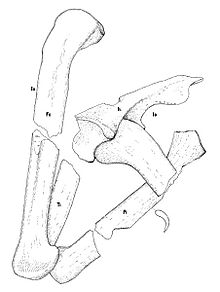Poposaurus
|
Poposaurus Temporal range: Late Triassic, 216 Ma |
|
|---|---|
 |
|
| Illustration of UR 357, the holotype specimen of Poposaurus gracilis (1915) in the collections of Field Museum. | |
| Scientific classification | |
| Kingdom: | Animalia |
| Phylum: | Chordata |
| Class: | Reptilia |
| Family: | †Poposauridae |
| Genus: |
†Poposaurus Mehl, 1915 |
| Species | |
| Synonyms | |
|
|
Poposaurus is an extinct genus of pseudosuchian archosaur from the Late Triassic of the southwestern United States. It belongs to the clade Poposauroidea, an unusual group of Triassic pseudosuchians that includes sail-backed, beaked, and aquatic forms. Fossils have been found in Wyoming, Utah, Arizona, and Texas. Except for the skull, most parts of the skeleton are known. The type species, P. gracilis, was described by M. G. Mehl in 1915. A second species, P. langstoni, was originally the type species of the genus Lythrosuchus. Since it was first described, Poposaurus has been variously classified as a dinosaur, a phytosaur, and a "rauisuchian".
Like theropod dinosaurs, Poposaurus was an obligate biped, meaning that it walked on two legs rather than four. However, as a pseudosuchian, it is more closely related to living crocodilians than to dinosaurs.Poposaurus is thought to have evolved this form of locomotion independently, possibly from early archosaurs' ability to high walk.
Poposaurus was about 4 metres (13 ft) long, with the tail comprising about half the body length. It is estimated to have weighed around 60 to 75 kilograms (132 to 165 lb), with the largest individuals reaching 90 to 100 kilograms (200 to 220 lb). The body of Poposaurus is laterally compressed, with a long and narrow hip structure. The pubis and ischium are elongated. The end of the pubis forms a distinct hook that is unique to Poposaurus and a few other early pseudosuchians. Poposaurus has five sacral vertebrae connecting the spine to the hip, three more than most early archosaurs. The hind legs are about twice as long as the arms and placed close together. Five digits are present on the foot, but the fifth is reduced to a small splint of bone next to the metatarsals. The middle three toes are well-developed, giving the foot a tridactyl appearance. The calcaneum bone extends far from the ankle to form a distinct heel.
...
Wikipedia
